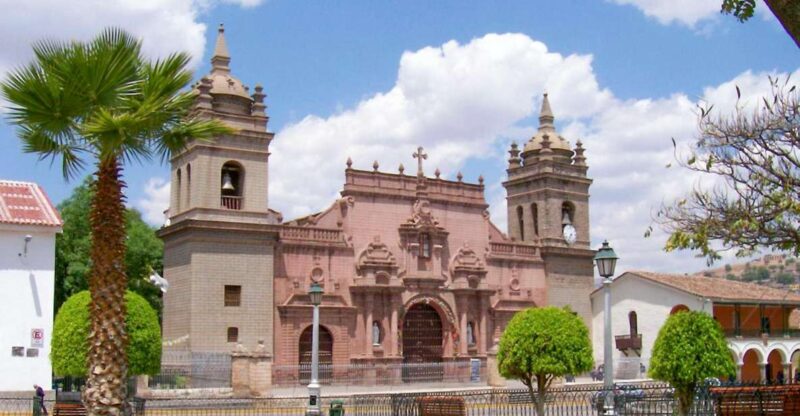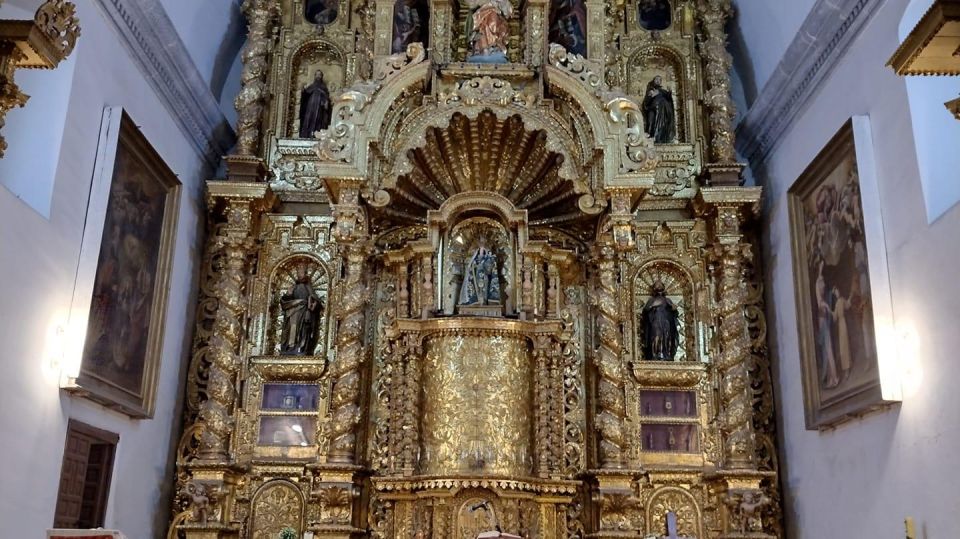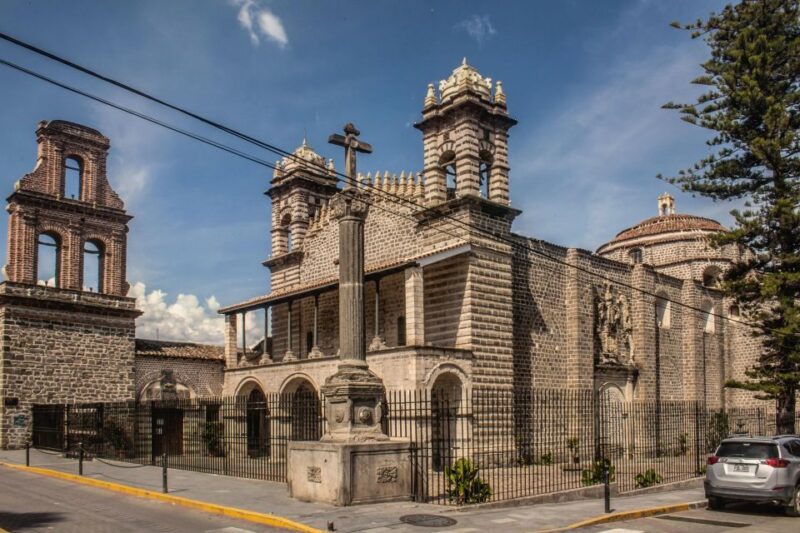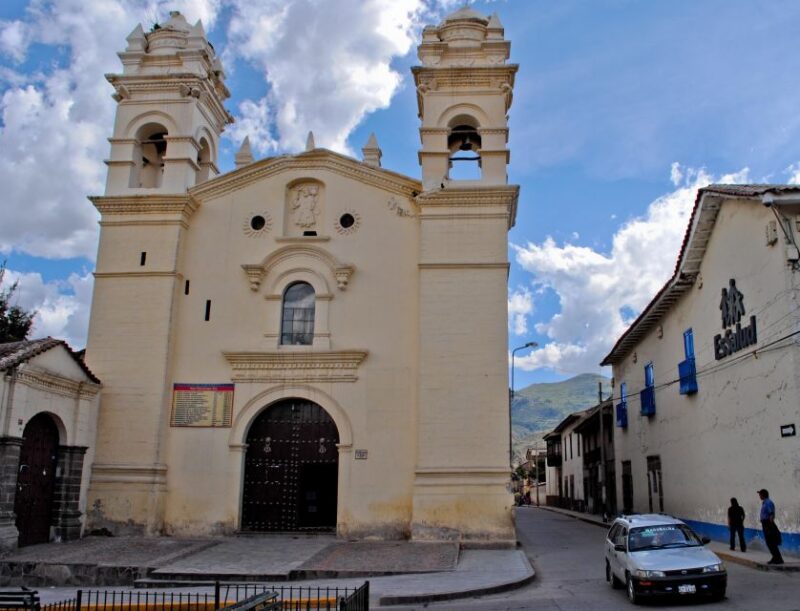Ayacucho’s colonial temples stand as striking symbols of its intricate history, merging Baroque elegance with indigenous craftsmanship. From the majestic Cathedral Basilica to the ornate Temple of Santo Domingo, these structures don’t just serve spiritual purposes; they narrate narratives of cultural fusion and colonial legacies. Visitors can admire the detailed altarpieces, rich with local artistic influences, that capture the essence of a tumultuous past. As one explores these architectural masterpieces, they might wonder what stories lie hidden within their walls, waiting to be uncovered.
Key Points

- Ayacucho’s colonial temples blend indigenous and Spanish architectural styles, showcasing rich baroque features and intricate altarpieces.
- The Cathedral Basilica of Ayacucho is renowned for its stunning baroque altarpiece adorned with gold leaf.
- Temples like Santo Domingo and San Francisco de Paula feature vibrant altarpieces reflecting local artistic traditions and cultural narratives.
- Preservation efforts are vital to maintain these historical sites amidst growing tourism and structural wear.
- Visiting these temples offers insights into Ayacucho’s complex history and cultural identity through their unique designs and stories.
Overview of Ayacucho Temples

Ayacucho’s colonial temples showcase a rich tapestry of history and architecture, reflecting the city’s cultural heritage and religious significance.
Visitors are drawn to the Cathedral Basilica of Ayacucho, a stunning example of baroque architecture with intricate altarpieces.
The Temple of Santo Domingo offers not only breathtaking architecture but also a museum and a panoramic viewpoint that frames the city beautifully.
San Francisco de Paula Temple captivates with its high choir and ornate altarpieces, while the Temple of the Company of Jesús stands as a testament to colonial craftsmanship.
Each temple invites exploration, revealing stories of faith and artistry that have shaped Ayacucho’s identity.
These sacred sites serve as a vital connection to the past, enriching any visitor’s experience.
You can also read our reviews of more tours and experiences in Ayacucho.
Key Historical Significance

The colonial temples of Ayacucho serve as vital historical markers, reflecting the region’s blend of indigenous and Spanish influences that shaped its cultural landscape.
These structures not only showcase unique architectural styles but also embody the complex history of colonialism and resistance. Their significance extends beyond aesthetics, offering insights into social, religious, and economic dynamics of the time.
-
Cultural Fusion: They illustrate the coexistence of indigenous traditions and European customs.
-
Historical Narratives: Each temple tells a story of colonial power and local adaptation.
-
Artistic Heritage: The altarpieces and decor encapsulate the artistic expressions of a pivotal era.
These elements make Ayacucho’s colonial temples essential for understanding Peru’s rich historical tapestry.
Architectural Styles and Features

Colonial temples in Ayacucho exhibit a captivating blend of Baroque and indigenous architectural styles, showcasing intricate altarpieces and unique structural elements that reflect the region’s rich cultural heritage.
The facades often feature elaborate decorations, with curvilinear forms and geometric patterns that highlight local craftsmanship.
Inside, the temples boast high ceilings and expansive nave spaces, creating an awe-inspiring atmosphere.
Wooden altarpieces, often gilded, stand as focal points, adorned with religious imagery that tells the stories of faith and devotion.
Plus, the use of local materials, such as adobe and stone, enhances the temples’ connection to the surrounding landscape.
Together, these architectural features create a harmonious dialogue between European influences and indigenous traditions, making Ayacucho’s colonial temples a true marvel.
Notable Altarpieces to Admire
Visitors can marvel at the stunning altarpieces within Ayacucho’s temples, each showcasing intricate craftsmanship and rich religious symbolism that reflect the region’s unique cultural heritage.
These artistic masterpieces not only enhance the spiritual atmosphere but also tell stories of faith and devotion.
Among the notable altarpieces, three stand out for their beauty and historical significance:
-
Cathedral Basilica of Ayacucho Altarpiece – An exquisite representation of baroque style, adorned with gold leaf and detailed carvings.
-
Temple of Santo Domingo Altarpiece – Features vibrant colors and intricate figures that depict various saints.
-
San Francisco de Paula Temple Altarpiece – Showcases a dynamic blend of indigenous and Spanish artistic influences, captivating visitors with its unique narrative.
These altarpieces truly embody Ayacucho’s rich artistic legacy.
More Great Tours NearbyCultural Influences in Design
Cultural influences in Ayacucho’s temple designs reveal a fascinating tapestry of indigenous traditions intertwined with Spanish colonial artistry. The intricate altarpieces often showcase native motifs, reflecting local beliefs and practices.
Craftsmen used traditional techniques, merging them with European styles, creating unique architectural forms. For instance, the use of vibrant colors and symbolic imagery in altarpieces highlights the blend of spiritual narratives from both cultures.
Plus, the construction methods employed local materials, emphasizing sustainability and community involvement. This synthesis not only enriches the aesthetic appeal of the temples but also serves as a testament to the resilience and adaptability of Ayacucho’s cultural heritage, making these sacred spaces a living history of artistic collaboration.
Visitor Experience and Recommendations
Experiencing the stunning architecture and rich history of Ayacucho’s temples offers a unique opportunity to appreciate the harmonious blend of indigenous and Spanish influences firsthand.
Visitors should consider the following recommendations to enhance their experience:
-
Plan Your Visit: Check the opening hours and plan around the best times to avoid crowds.
-
Bring Essentials: A camera and cash are essential for capturing memories and making small purchases at local shops.
-
Engage with Guides: Take advantage of guided tours to gain deeper insights into the history and significance of each temple.
Practical Information for Tourists
When planning a trip to Ayacucho’s colonial temples, travelers should consider essential practical information to ensure a smooth and enjoyable experience.
Tours typically last five hours and are available in English and Spanish. Starting times vary, so checking availability is crucial. Pricing begins at K936 per person, and travelers can enjoy free cancellation up to 24 hours in advance. It’s advisable to reserve now and pay later.
Visitors should bring a camera and cash, while alcohol and drugs are prohibited. The tour includes food and entrance tickets but isn’t suitable for wheelchair users or those with certain medical conditions.
Lastly, tours proceed in sunny weather or as weather permits, so dress accordingly.
Preservation and Restoration Efforts

Efforts to preserve and restore Ayacucho’s colonial temples have become increasingly important as tourism grows and the structures face natural wear and environmental challenges. Local authorities, along with cultural organizations, are actively working on several initiatives to ensure these historical sites remain intact for future generations.
Regular maintenance is a key strategy, with routine inspections and repairs conducted to address any structural issues promptly.
Community involvement plays a significant role, as local residents engage in preservation workshops, learning techniques to care for their heritage.
Funding and grants from both government and international sources support restoration projects, allowing for more extensive renovations.
These collaborative efforts not only protect the architectural beauty of Ayacucho but also enhance its cultural significance, enriching the tourism experience.
Frequently Asked Questions
What Is the Best Time to Visit Ayacucho Temples?
The best time to visit Ayacucho’s temples is during the dry season, from May to October. Visitors enjoy pleasant weather, making exploration of the stunning architecture and altarpieces more enjoyable and comfortable.
Are Guided Tours Available for Non-Spanish Speakers?
Yes, guided tours are available for non-Spanish speakers. They typically offer tours in English, ensuring everyone can fully appreciate the rich history and stunning architecture of the temples while enjoying an informative experience.
Is There a Dress Code for Visiting the Temples?
There isn’t a strict dress code for visiting the temples, but visitors should wear respectful attire. Modest clothing is encouraged, ensuring a respectful experience while exploring the rich cultural heritage and spiritual significance of these sites.
Can I Take Photos Inside the Temples?
Visitors can take photos inside the temples, but they should respect any specific guidelines set by the site. It’s always good to ask staff beforehand to ensure a smooth experience during their visit.
What Food Options Are Available During the Tour?
During the tour, participants enjoy a selection of food options included in the package. They can savor local dishes, enhancing their experience while exploring the temples and appreciating the rich cultural heritage of the area.
Recap
To sum it up, Ayacucho’s colonial temples stand as vibrant testaments to the region’s historical and cultural richness.
Their unique architectural styles and stunning altarpieces invite visitors to explore the intricate stories woven into each structure.
As travelers enjoy this captivating blend of Baroque and indigenous influences, they not only appreciate the artistry but also gain insight into the complex narratives of colonial power and resistance.
Ayacucho’s temples are truly essential destinations for anyone seeking to understand Peru’s diverse heritage.
You can check availability for your dates here:More Tour Reviews in Ayacucho
Not for you? Here's more nearby things to do in Ayacucho we have reviewed
- 19 Best Tours In Ayacucho
- Private Tour to Wari and Quinua
- Huancaraylla Tours Millpu Ayacucho 3 Days 2 Nights
- Rainbow Mountain – ¡..All Included Service..!
- VilcasHuaman – Inca Culture
- 4 Best City Tours In Ayacucho
- ATV Tour: Quad Biking Sacred Valley
- Full Day Turquoise Waters Millpu
- Turquoise Waters Ayacucho
- From Ayacucho || Wari and Quinua Culture Tour ||
- From Ayacucho: a Waterfall Tour – Full Day
- From Ayacucho: Pikimachay Huanta – Full Day
